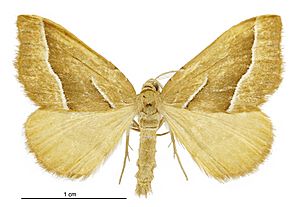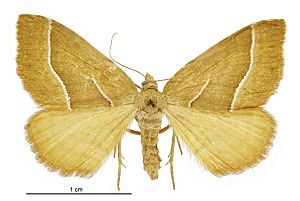Asaphodes stinaria facts for kids
Quick facts for kids Asaphodes stinaria |
|
|---|---|
 |
|
| Male | |
 |
|
| Female | |
| Conservation status | |
 Nationally Vulnerable (NZ TCS) |
|
| Scientific classification | |
| Kingdom: | |
| Phylum: | |
| Class: | |
| Order: | |
| Family: | |
| Genus: |
Asaphodes
|
| Species: |
A. stinaria
|
| Binomial name | |
| Asaphodes stinaria (Guenée, 1868)
|
|
| Synonyms | |
|
|
The Asaphodes stinaria is a type of moth that belongs to the Geometridae family. It is special because it is found only in New Zealand. This moth is currently listed as Nationally Vulnerable by the Department of Conservation, meaning it needs protection.
Contents
Discovering the A. stinaria Moth
This moth was first described in 1868 by a scientist named Achille Guenée. He found a specimen in the Canterbury area of New Zealand. This specimen had been collected by Richard William Fereday.
Guenée first gave the moth the name Camptogramma stinaria. Later, in 1898, another scientist, George Vernon Hudson, moved it to a different group called Xanthorhoe. Finally, in 1971, John S. Dugdale placed it in its current group, Asaphodes. The original moth specimen used for its first description is kept safe at the Natural History Museum, London.
What the A. stinaria Moth Looks Like
When Guenée first described this moth, he noted its unique appearance. The top wings are a yellowish-brown color, mixed with some darker, blackish areas. They have two thin, white lines that are outlined in black. One line has a single bend, and the other is simply wavy.
The bottom wings are also yellowish-brown. They don't have many markings on top. However, underneath, they are reddish and have six parallel lines. The moth's body is the same color as its wings. The male moths have special antennae with long, feathery parts.
Where the A. stinaria Moth Lives
The A. stinaria moth is found only in New Zealand. In the past, it lived in many different places across the country. These included areas like Taupo, Hawkes Bay, and various parts of Canterbury. It was also found in Dunedin and Fiordland.
However, recently, this moth has become harder to find in some of these older locations. Today, it is mainly found in areas like Westland, Central Otago, Otago Lakes, and Southland. This shows that its living range has become much smaller.
Moth Life and Home
Adult A. stinaria moths are usually seen flying between November and March. December is the month when they are most commonly found. These moths like to live in several different types of places.
They can be found in wetlands, which are areas with lots of water. They also live in tussock country, which is open land with clumps of grass. You might also spot them in open, grassy spots within forest areas.
What the Moth Eats
Scientists believe that the A. stinaria moth might be linked to certain plants. One early record suggests that it visited a plant called Carex subdola.
Currently, it is thought that the moth is connected to a type of "hairy" Ranunculus plant. However, the exact name of the specific plant it eats is still not fully confirmed. More research is needed to be sure.
Protecting the A. stinaria Moth
The number of A. stinaria moths has gone down a lot recently. It is even thought that the moth might disappear from the eastern parts of New Zealand. Because of this, the moth is now listed as "Nationally Vulnerable" under the New Zealand Threat Classification System. This means it is at high risk of becoming extinct.
One of the main reasons for its decline is believed to be the destruction of its habitat. Another possible reason is overgrazing by animals. This happens when too many animals eat the plants that the moth might depend on for food or shelter. Protecting its habitat and food sources is very important for the survival of this unique New Zealand moth.
Images for kids


